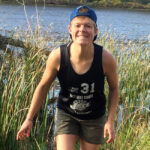Blog by Ambassador Shannon Conk, who will spend August 21 biking, paddling, running, hiking, and swimming through the urban landscape of Minneapolis, MN. Her metropolitan adventure will highlight the importance, accessibility, and low-barrier entry of wild spaces and outdoor recreation within a major city.
It’s 4pm on a Tuesday in late August. The sun is so bright it feels like it fills half the sky, the beams violently attempting to burn right through my retinas. The air is heavy with sweat and smog and steam, and threatens to crumple me into a soggy pile of apathy if I don’t keep pedaling. Underneath me, sticky black tires roll across the Wirth Parkway bridge as heat radiates from the worn asphalt of the interstate below, eliciting beads of glistening sweat as I push-pull push-pull to escape the concrete jungle.
I turn off the paved bike lane and through an open metal gate, the feeling of dirt grinding beneath my tires: the first blatant sensory marker of the transition. The city noises fade away as I leave the concrete / the chain links / the low chorus of thousands of running engines, red brake lights forming parallel streams of varying speeds. The trail weaves through 10 seconds of prairie and open skies but the woods quickly swallow me up, and I emerge into a space so still that I feel like I just rolled into an entirely different worlds.
The city noises fade away as I leave the concrete / the chain links / the low chorus of thousands of running engines, red brake lights forming parallel streams of varying speeds.
A dirt path instead of a paved sidewalk, bluebirds instead of planes, climbing ivy instead of highway sound barriers, towering oaks and maples instead of towering towers. In many ways, it is the same – just physical obstacles we encounter as we move through the world. But in more important ways, it is completely different.
The second you enter the woods, the temperature drops and your body slices through cooler air with every push-pull rotation. It smells different – layers of decaying leaves, crushed pine needles, wet soil, notes of my grandma’s basement. Rays of sunshine stream sideways, filtering through trunks and branches and vines and leaves – only a small fraction of light finding a path uninterrupted enough to reach the forest floor. Dust, swarms of gnats, seeds outfitted with a silky plant parachute — anything light enough to float is subjected to becoming glowing forest magic. This swirling aggregate of matter is invisible until it passes through narrow projections of light where it is suspended in a window, temporarily absorbing heat and light delivered from a glowing ball of energy 93 million miles away. That light barreled through space for 8 minutes and 18 seconds to fill each forest window and light every spec of dust. Dust that becomes glitter. The same as the moon sparkles on the dark ocean waters off California. The same as the columns and plates of snow crystals that blanket the Rockies and reflect a rainbow of colors as the sun encounters the frozen angular structures. It’s the same sun that is streaming through Wirth as I try to appreciate it without losing focus on the trail.
It sounds different. Leaves brush against leaves from their own tree self. They brush against leaves from other trees. They don’t discriminate in their leaf high-fives. Squirrels make dramatic movements, darting across trails as if every zig and every zag was a matter of life or death. They flick their tails decidedly, as if they have something important to say and dammit you will hear them out. They chase their lovers and their enemies in laps around tree trunks, a hybrid of tag and hide and seek. They chatter loudly, maybe at me, maybe at each other, maybe at themselves, maybe that there are more and more of these humans around these days – the neighborhood has really changed… The woods feel quiet after escaping the city but as you adjust, you hear just how much the woods have to say.
When I enter that space it feels like taking a deep breath. It feels like jumping into a cold, clear swimming hole. It feels like lying down after a long day. It feels like clarity, and relief, and purpose.
When I enter that space it feels like taking a deep breath. It feels like jumping into a cold, clear swimming hole. It feels like lying down after a long day. It feels like clarity, and relief, and purpose. I know that the only thing I have to do for the next hour is navigate my body through a series of trees and turns and stumps and rock piles. The only space available for processing thoughts is dedicated to keeping myself on the 12 inch path that weaves through the woods. I can’t think about Roth IRAs, or ICE or El Paso and Dayton. I can’t think about how many years it’s been since I was at the dentist last, and if my parents think I’m floundering, or if I think I’m floundering, and how I need to call State Farm, and why I haven’t been practicing my Spanish. I can’t think about how I’ve been going to bed too late and how I need to call back a friend I worry about a lot but feel ineffective in connecting with her, and how I hope my brother is doing ok. About how I’m constantly fluctuating between feeling like I’m unqualified to do anything and feeling like I’m smart, and adaptable, and could pick up anything. About how my parents are getting older and I am too. About not understanding most things in life.
None of those things can enter my consciousness in this space. I just have to look forward and tell my body what to do next. Anticipate the turns. Lean in. Brake less. Drop seat. Navigate rocks. Stay balanced. Time pedals. Don’t overthink. Stand up. Breathe. When I’m in that space, it’s one of the few times when I stay totally focused on what I’m doing, and the space I’m doing it in. This exercise, above all else, makes me feel overwhelmingly grateful. I never leave the woods in a worse place than when I started. I leave the woods with gratitude, perspective, the chemical remnants of endorphins rushing through my body, and sometimes with a new scrape or two. I leave the woods feeling present and alive.
I never leave the woods in a worse place than when I started. I leave the woods with gratitude, perspective, the chemical remnants of endorphins rushing through my body, and sometimes with a new scrape or two. I leave the woods feeling present and alive.
These woods are surrounded by the twin cities of Minneapolis and St. Paul. Beyond that is a ring of suburbs, and then another, and then at least one more. It is easy for us to get sucked into the narrative that cities can’t have wild places or that our backyards don’t count as nature. It is easy to think that I need to go up north, or back to the Rockies, or to the nearest state park to find some sort of wilderness. But this city, just like many cities, has woods, prairie, streams, rivers, cliffs, and wetlands. This city, like all cities, provides opportunities to explore the undeveloped, to find solitude, to look up and see nothing but the treetops, hear nothing but the winds weaving through the leaves.
There is an inherent danger in thinking of nature as somewhere far away from where most of us live. In thinking nature is just national parks and dramatic landscapes like the peaks of the Rocky Mountains or the sandstone Arches of Eastern Utah. Nature is everywhere we go, in the regional parks and the city parks, the railroad corridor and your backyard. These places let us escape from the nonstop drone of traffic, from the heat of asphalt and concrete and skyscraper roofs, from the hustle of our commute and the depths of our work email inbox. They provide a space to let go, recharge, and emerge in a better space than when you arrived.
These urban spaces are where more people can foster a relationship with the outdoors, find peace and quiet in the busy city, and build confidence and resilience through the activities these spaces afford.
This space allows me to be ok with all the uncertainty in life. This space creates room for reflection, for feeling every emotion, for focus, for healing, and happiness so pure I laugh to myself and by myself for minutes on end. Everyone should have the chance to experience the benefits of the outdoors, regardless of where you live, how much you make, your race and gender, and if you grew up on the ski team. These urban spaces are where more people can foster a relationship with the outdoors, find peace and quiet in the busy city, and build confidence and resilience through the activities these spaces afford.
To highlight the opportunities in our own urban landscape to get outside and explore, I am biking, hiking, paddling, swimming, and running through Minneapolis. The point in finding outdoor adventure nearby is to emphasize the barriers to outdoor spaces for many people — financial, logistical, cultural — we could make large lists under each of these categories that explains why certain people have been excluded from certain activities and spaces. This isn’t a perfect exercise in absolute accessibility — I’ll be renting a kayak, using a bike I own, and will complete each segment drawing on experiences that I was very privileged to have growing up and as an adult. But it is an exercise in finding some of the free and low cost opportunities that exist right around the corner, that a Minneapolis resident could get to without a car, without a whole ton of #gear, and with little or no experience in that space. In the context of The Cairn Project’s mission, discovering these pockets of accessible urban wilderness can help create, sustain and inspire a relationship with the outdoors for girls who are least likely to have such opportunities. We all start somewhere, and where better than our own communities.


Shannon Conk
Ambassador Shannon Conk will spend August 21 biking, paddling, running, hiking, and swimming through the urban landscape of Minneapolis, MN. Her metropolitan adventure will highlight the importance, accessibility, and low-barrier entry of wild spaces and outdoor recreation within a major city. See her ambassador page.
